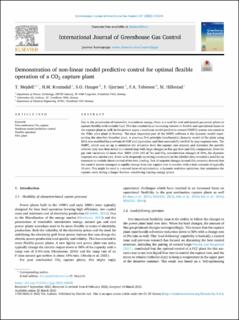| dc.contributor.author | Mejdell, Thor | |
| dc.contributor.author | Kvamsdal, Hanne Marie | |
| dc.contributor.author | Hauger, S.O. | |
| dc.contributor.author | Gjertsen, Fredrik | |
| dc.contributor.author | Tobiesen, Finn Andrew | |
| dc.contributor.author | Hillestad, Magne | |
| dc.date.accessioned | 2022-11-18T13:22:56Z | |
| dc.date.available | 2022-11-18T13:22:56Z | |
| dc.date.created | 2022-04-09T17:02:48Z | |
| dc.date.issued | 2022 | |
| dc.identifier.citation | International Journal of Greenhouse Gas Control. 2022, 117 1-11. | en_US |
| dc.identifier.issn | 1750-5836 | |
| dc.identifier.uri | https://hdl.handle.net/11250/3032902 | |
| dc.description.abstract | Due to the penetration of renewable intermittent energy, there is a need for coal and natural gas power plants to operate flexibly with variable load. This has resulted in an increasing interest in flexible and operational issues in the capture plant as well. In the present paper a nonlinear model predictive control (NMPC) system was tested at the Tiller pilot plant in Norway. The most important part of the NMPC software is the dynamic model representing the absorber/desorber plant. A previous first principle (mechanistic) dynamic model of the plant using MEA was modified for a solvent of AMP and piperazine, and then successfully verified by step response tests. The NMPC, which was set up to minimize the deviation from the capture rate setpoint and minimize the specific reboiler duty was then tested in a closed loop with large changes in flue gas flow and CO2 composition. Even for gas rate variations of more than 300% (110–340 m3/h) and CO2 concentration changes of 30%, the dynamic response was satisfactory. A test with frequently occurring constraints on the reboiler duty revealed a need for an extension to include direct control of the lean loading. Test of setpoint changes in total CO2 recovery showed that the control system managed to rapidly change from one capture rate to another with a time constant of typically 10 min. This might be used in a second layer of optimization, a dynamic real-time optimizer, that minimizes the capture costs during a longer horizon considering varying energy prices. | en_US |
| dc.language.iso | eng | en_US |
| dc.publisher | Elsevier | en_US |
| dc.rights | Navngivelse 4.0 Internasjonal | * |
| dc.rights.uri | http://creativecommons.org/licenses/by/4.0/deed.no | * |
| dc.subject | Pilot plant | en_US |
| dc.subject | Flexible operation | en_US |
| dc.subject | Nonlinear model predictive control | en_US |
| dc.subject | CO2 capture | en_US |
| dc.subject | Post-combustion | en_US |
| dc.title | Demonstration of non-linear model predictive control for optimal flexible operation of a CO2 capture plant | en_US |
| dc.type | Peer reviewed | en_US |
| dc.type | Journal article | en_US |
| dc.description.version | publishedVersion | en_US |
| dc.rights.holder | © 2022 The Authors. Published by Elsevier Ltd | en_US |
| dc.source.pagenumber | 1-11 | en_US |
| dc.source.volume | 117 | en_US |
| dc.source.journal | International Journal of Greenhouse Gas Control | en_US |
| dc.identifier.doi | 10.1016/j.ijggc.2022.103645 | |
| dc.identifier.cristin | 2016415 | |
| dc.source.articlenumber | 103645 | en_US |
| cristin.ispublished | true | |
| cristin.fulltext | original | |
| cristin.qualitycode | 1 | |

